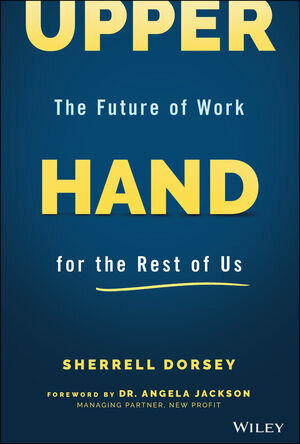Upper Hand: The Future of Work for the Rest of Us
It is anticipated that over the next decade, over 30 percent of the workforce in the United States will need to be retrained or change jobs due to shifts in technology and automation. With this impeding shift, much needs to be done to ensure that marginalized Black and brown communities, who have already been left behind and disadvantaged by the digital divide, are able to adapt to and navigate this future.
As Sherrell Dorsey argues in Upper Hand: The Future of Work for the Rest of Us, “We’ve made getting into the technology space extremely complex. But it doesn’t have to be…we can include ourselves in the rooms and tables that will carry us into opportunities that enable higher salaries, strategies for navigating an education that won’t leave us in insurmountable debt, and career prospects that allow us to be pillars within our families and communities.”
This is exactly what Dorsey's book aims to do. She crafts a call to action for both individuals and society that uses personal stories, evidence, and clear action items as a guide toward achieving a more equitable future within this shifting landscape.
Upper Hand is partly the story of Dorsey’s life as a Black female data journalist and entrepreneur, from her start as a teen enrolled in technology-focused education, to becoming a successful blogger and content marketer, to founding and leading The Plug, a Black tech news and insights platform. She shares how she was able to navigate a sphere traditionally dominated by white men, highlighting both successes and failures in the process.
“I recognize how fortunate I was to have the right information at the right time to access the resources available to me,” she writes. “Navigating available opportunities is not an easy task, especially when information is scattered, time is limited, or you simply don’t know where to start.” In Upper Hand, Dorsey provides an invaluable resource, a guide for others to follow in her footsteps. She is “changing the narrative of who [is] poised to create the future.”
What makes Dorsey’s book so compelling is that these glimpses into her own life are framed within the broader narrative of marginalized groups in America, in particular Black and brown communities in technology. No stone is left unturned as she explores the depth and breadth of challenges faced by Black and brown communities, including how redlining pushes them into less desirable neighborhoods where schools are unable to offer courses that lead to opportunities in tech-related fields; how non-traditional experiences and innovation are undervalued, despite often requiring many of the same skills and knowledge; and how the COVID-19 pandemic has both exacerbated existing inequalities and provided new opportunities.
As Dorsey notes, these structural and social challenges that have disadvantaged Black and brown communities prevented them from becoming part of the tech sector are also detrimental to broader progress. The challenges we face today require a diverse workforce with a range of skills and experiences. “The increasing problems we face in society today, like threats to our privacy online, climate change, inaccessible banking tools, and other socially inextricable challenges, won’t be solved by white guys in hoodies alone,” writes Dorsey. The tech sector needs the creativity of those who are able to make do with what they have, whether it fits a traditional mold or not.
This is the future that Dorsey is calling for—one where Black and brown communities use their unique experiences to solve problems in creative ways. And instead of just sharing a vision, she opens the door to make it a reality.
This is what sets this book apart from other calls for change in the tech sector, beyond the lack of jargon and refreshing narrative style. At its core, this is a guidebook. Dorsey wants her audience to walk away with a list of concrete actions they can take to get into the tech industry, which can often feel inaccessible and exclusive. She does this by providing the reader with resources and action items that will help them take meaningful steps toward claiming a space in the industry, such as definitions of terms, lists of companies and networking organizations, and possible jobs to consider, with information on salaries, educational requirements, and required skills.
Each chapter ends with action items ranging from simple steps like getting a LinkedIn profile to deeper questions to ask oneself so as to be intentional in taking those actions. In the chapter on education, action items include having open conversations with family about what resources they may have to support postsecondary education, creating a financial strategy, and trying out introductory courses in topics to gauge one’s level of interest before diving into an expensive degree program. In the chapter on entrepreneurship, Dorsey suggests using online resources to start a side hustle and look beyond one’s physical community for support.
Her action items are practical, are often free or low-cost, and provide a road map for launching and growing one’s career in the tech sector. But the advice goes beyond those jobs usually associated with technology, such as software developers or IT. Dorsey includes many tech-adjacent roles in her discussions, including a full range of individuals who support technology in various areas from human resources to accounting to marketing. Much of her advice, like building a compelling narrative that explains how one’s experience and background helped prepare for that career, is widely applicable regardless of field.
Dorsey’s message is one of hope and inclusion, anchored in clear actionable steps that can be taken by both individuals and the tech sector more broadly to create a more equitable future—opening a door that has long been closed to many. As she says at the end of her introduction, “I can’t wait to see you all on the other side.”
Kate Meyers Emery is digital communications manager at Candid.






